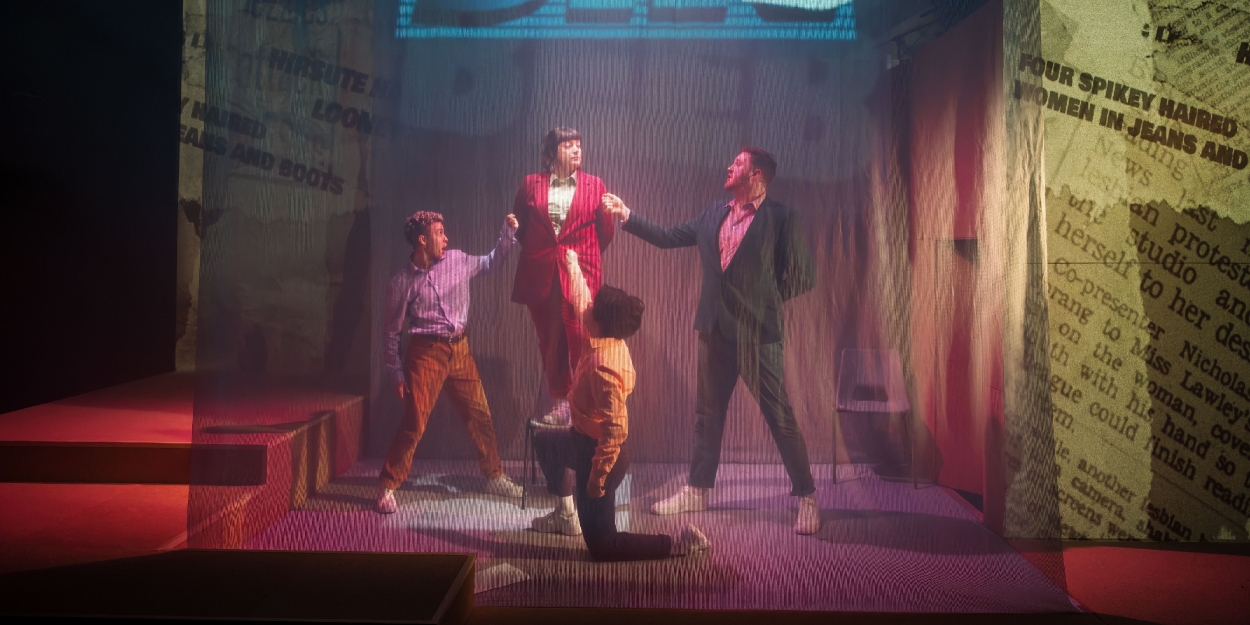Review: AFTER THE ACT, New Diorama Theatre
An ambitious verbatim musical about Section 28

![]() After the Act is entirely different to any other musical currently running in London. Worlds away from the glitz and the glamour of the West End, theatre company Breach have tackled an era of British queer history through the form of a verbatim musical, and the result is a raw, creative performance like nothing else.
After the Act is entirely different to any other musical currently running in London. Worlds away from the glitz and the glamour of the West End, theatre company Breach have tackled an era of British queer history through the form of a verbatim musical, and the result is a raw, creative performance like nothing else.
Presented by a cast of four in New Diorama's small, black-box style space, After the Act takes us from the introduction of Section 28 through to the present day. We see the broader political strokes of the era and the stories of the individuals it directly impacted side by side, painting a powerful picture of the climate of homophobia in the 80s and 90s. What makes this production so different to any other queer musical, however, is the fact that it's a piece of verbatim theatre - every word is taken from interviews with real life individuals.
While verbatim plays are becoming steadily more popular, there are still very few examples of verbatim musicals - the most well-known perhaps being London Road, which used interviews with residents of the titular street in Ipswich in wake of the serial murders there. The form is often used for shows that deal with activism and politics, such as Lucy Ellison's Torycore, which put Conservative speeches to metal music. After The Act also uses political speeches, and despite its more pop music style, remains similarly hard-hitting, connecting us directly with individuals rather than taking a sweeping historical approach.
Putting real life speech patterns to music can't be easy, but After the Act uses this to its advantage - the songs all feel somewhat erratic and verbal, forcing us to really listen to the words themselves. Writers Ellice Stevens and Billy Barrett have excelled in singling out phrases to use as choruses, drawing on campaign slogans and interview confessions. Composer Frew, who appears onstage on a high balcony like a kind of sports commentator, connects the words to their time period through 80s synths and pulsing rhythms.
This frenetic quality is found in the direction and choreography too, by Billy Barrett and Sung Im Her respectively. There's a lot of shoulder popping and strange rhythmic arm movements. The whole piece is stylised and quirky, not pretending to be polished. The vocals are off on more than one occasion, with unbalanced harmonies, and the dance moves are often out of time, but remarkably it doesn't spoil the performance, instead emphasising the rawness of the production.
The cast feel more like real people than typical musical theatre ensembles, which helps the production stay in touch with the interviews it is based on. The four performers all play characters of various genders over the course of the show, with all treated in a gender neutral way, which is really effective.
After the Act deals a lot with media coverage and bias in its first act, which is highlighted by Lizzy Leech's set. Translucent fabric hangs over the stage, creating separate zones onstage for TV screens and the pages of a book. This is gradually deconstructed, as Act 2 takes place on a much barer stage - it's very clever, and a great example of set design that helps the storytelling of the show along without drawing too much attention to itself. The costumes undergo a similar transformation, from 80s neon blazers to PE kits. The video design, by Zakk Hein, expands the world of the show, creating both moments of comedy and an opportunity to showcase real historical footage and materials.
Tonally, the production is more light-hearted than it sounds. There's a lot of wit in the script, and the cast find moments of physical comedy too, meaning this never feels like a history without hope. The ending is in many ways a call to action, even if it becomes a little too obviously signposted.
It's really exciting to see British queer history making its way to the stage. The focus so often seems to be on the US, leaving young LGBTQ+ people in the UK unaware of our own heritage. In this way, After the Act has a dual audience - those who remember Section 28 themselves, and those who want to learn about the generations before them. Both were present when I went to the show.
New Diorama is a theatre unafraid to cause disruption - their recent 'Intervention' saw the theatre closed for six months as they invested in artists and bold new work. It's hard to imagine this show at many other venues, highlighting the space's important role in cultivating out-of-the-box projects.
It may be a little rough around the edges, but After the Act is a bold, exciting piece of theatre that centres real-life queer British stories.
After the Act runs at New Diorama until 1 April
Photo Credit: Alex Brenner
Comments
Videos

